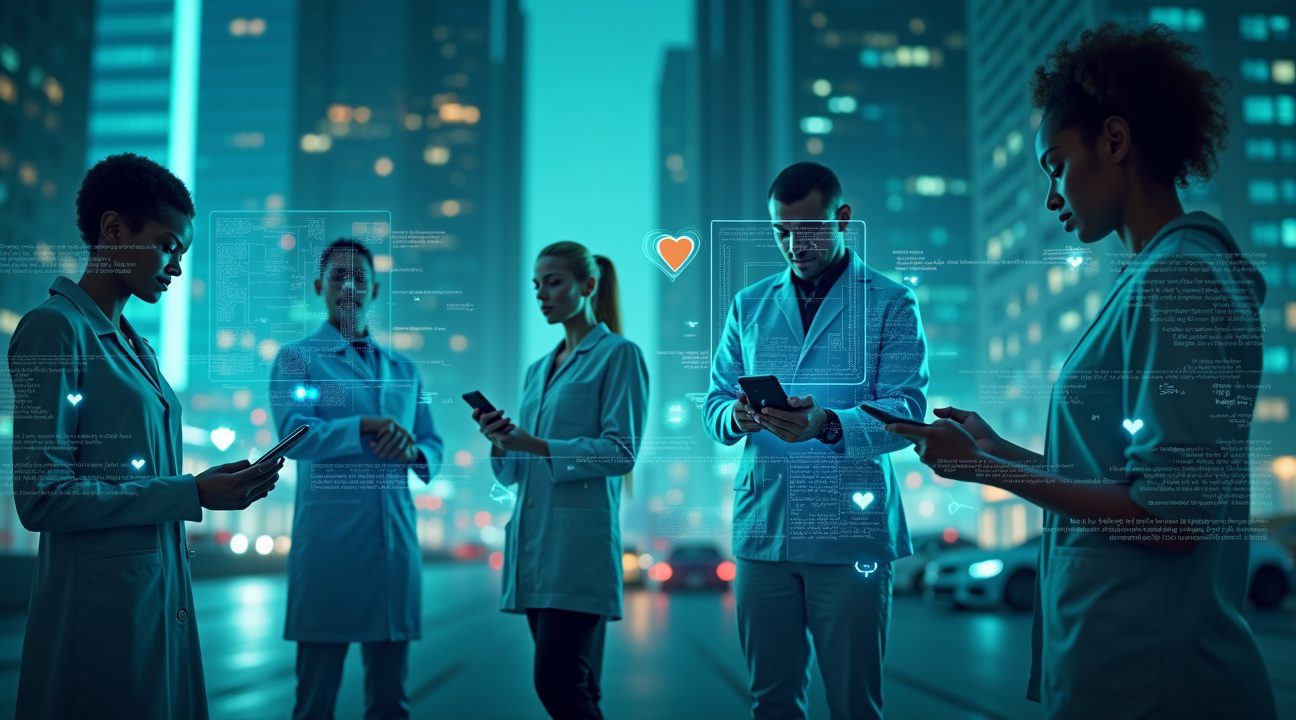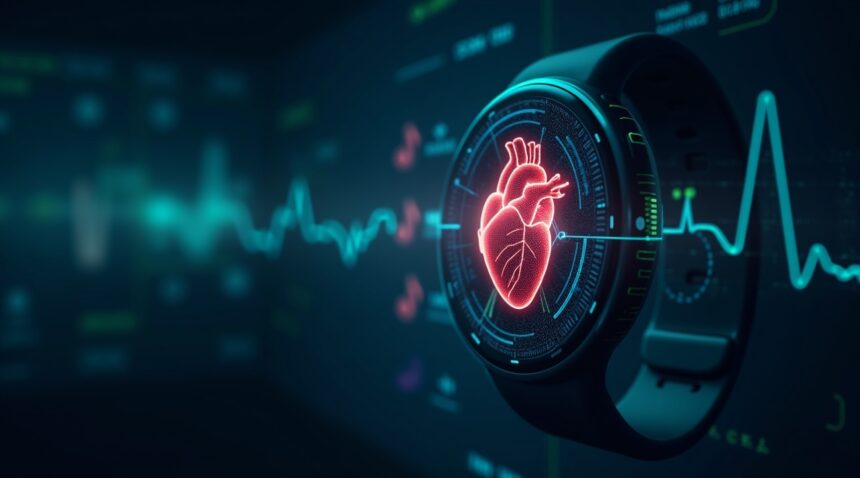Scientists have achieved a remarkable 96.6% accuracy in identifying individuals using only their heart rhythm patterns, marking a significant advancement in biometric security technology.
Key Takeaways
- Heart rhythm patterns serve as unique biological signatures that achieve up to 96.6% identification accuracy, surpassing many traditional biometric systems.
- Cardiac authentication offers enhanced security advantages over fingerprints and facial recognition since heart rhythms cannot be easily stolen, replicated, or spoofed.
- Consumer devices like smartwatches already contain the necessary sensors to implement heartbeat-based authentication without the need for additional hardware changes.
- The technology provides continuous and non-invasive monitoring that works universally across different populations and remains stable over an individual’s lifetime.
- Privacy concerns remain significant around medical data collection, necessitating approaches that include local data processing, minimization practices, and strong user consent mechanisms.
The Science Behind Cardiac Biometrics
Researchers have developed revolutionary biometric technology that examines five key musical traits—dynamics, rhythm, timbre, pitch, and tonality—of electrocardiogram (ECG) signals to construct precise and personalized identification systems. This advancement brings biometric recognition to a new level of sophistication and reliability.
Real-World Applications and Future Potential
Because many wearables like smartwatches already monitor heart rate data, integrating this authentication method into everyday technology could be both seamless and cost-effective. Continuous authentication enables proactive cybersecurity practices without requiring additional user input. For further insights into this emerging technology, visit this article on cardiac biometric identification.
Ethical and Privacy Considerations
As with any emerging data-centric tech, there are privacy risks concerned with biometric and health data. To address this, experts stress the importance of implementing privacy-first protocols. These include local data processing (avoiding cloud transmission), strict data minimization, and clarified user consent for all forms of data collection and use.
Scientists Achieve 96.6% Accuracy in Identifying People by Heart Rhythm Alone
Each person’s heartbeat creates a distinctive rhythm that forms a personalized waveform, functioning as a biological signature as unique as a fingerprint. Electrocardiogram recordings capture this cardiac symphony by measuring the heart’s electrical activity through specialized cells that trigger consistent, measurable patterns specific to each individual.
Scientists have discovered that ECG recordings contain five defining musical qualities that transform cardiac signals into analyzable biometric data. These parameters include dynamics, which measure the strength and intensity of heartbeat variations, and rhythm, which captures the timing patterns between beats. Timbre represents the characteristic quality of the heart’s electrical signature, while pitch analyzes the frequency components within the cardiac waveform. Tonality examines the harmonic relationships present in the heart’s electrical activity.
Revolutionary Accuracy in Cardiac Identification
Research demonstrates that combining these musical parameters yields a unique cardiac signature for each individual, achieving identification accuracy rates up to 96.6%. This breakthrough in non-invasive biometric technology offers several advantages over traditional identification methods:
- Higher accuracy than many conventional biometric systems
- Continuous monitoring capability without user interaction
- Resistance to spoofing since heart rhythms can’t be easily replicated
- Universal applicability across different populations and age groups
- Non-contact measurement potential through advanced sensing technologies
The heart’s electrical activity remains remarkably consistent for each person despite various factors including age, physical condition, and temporary health changes. This consistency stems from the unique architecture of each individual’s cardiac conduction system, which includes the sinoatrial node, atrioventricular node, and specialized muscle fibers that create person-specific electrical pathways.
Advanced signal processing techniques analyze these cardiac waveforms by converting them into frequency domain representations that highlight each person’s distinctive characteristics. Machine learning algorithms then process these converted signals to identify the unique patterns that distinguish one individual from another, much like how robotic systems adapt to different environments through pattern recognition.
This cardiac identification technology represents a significant advancement in biometric security, offering practical applications in healthcare monitoring, access control systems, and personal device authentication. The combination of high accuracy rates and the universal nature of heart rhythms positions cardiac biometrics as a promising solution for next-generation identification systems that prioritize both security and user convenience.

How Your Smartwatch Could Replace Your Password Using Heart Data
I’ve been tracking the development of biometric authentication for years, and the latest breakthrough comes from an unexpected source: your heartbeat. ECG devices, including wearable smartwatches and fitness bracelets, now record the heart’s electrical activity with enough precision to create a unique digital signature. These signals undergo analysis by sophisticated algorithms adapted from audio signal processing, transforming your cardiac rhythm into a personal identification key.
The Science Behind Heartbeat Recognition
Identification algorithms examine beat-to-beat intervals, known as RR intervals, which measure the time between consecutive heartbeats. This creates a data-rich, non-stationary signal that’s as distinctive as your fingerprint. Your heart doesn’t beat like a metronome – subtle variations in timing create a pattern that’s uniquely yours.
The beauty of this system lies in its simplicity. Records from just 50 beats, roughly one minute of measurement, provide sufficient data for accurate verification. I find this particularly impressive because it means authentication could happen almost instantly when you put on your device. Comparisons between different technologies show that ECG and PPG (photoplethysmogram) devices extract similar essential timing intervals, making this approach versatile across various consumer electronics.
Modern smartwatches and fitness trackers already possess the hardware needed for this technology. Many consumer devices can collect the necessary signals, and the algorithms can run as simple applications without requiring additional hardware modifications.
Accuracy and Real-World Performance
The accuracy rates achieved in testing are remarkable. Animal studies demonstrate equal error rates (EER) as low as 0.12-0.21%, while human studies show EERs ranging from 0.2% to 19.15% depending on dataset scale and methodology. These numbers translate to extremely reliable authentication in controlled conditions, though real-world performance varies based on factors like physical activity, stress levels, and device placement.
This non-invasive, low-cost approach offers significant advantages over traditional biometric methods. Unlike fingerprint scanners that can be fooled by replicas or facial recognition systems that struggle with lighting conditions, your heartbeat remains consistent and difficult to forge. The signal comes from within your body, making it nearly impossible for someone to steal or replicate your cardiac signature.
Space exploration technology has actually contributed to refining these algorithms, as astronauts’ vital signs need continuous monitoring in extreme conditions. The same principles now power consumer authentication systems.
Current implementations face some challenges:
- Physical exertion
- Emotional stress
- Medical conditions altering heart rhythm
However, adaptive algorithms account for these variations by learning your baseline patterns over time and adjusting for normal physiological changes.
Privacy concerns remain minimal since heartbeat data, unlike facial recognition or fingerprints, doesn’t reveal personal information to casual observers. Your cardiac signature exists only as mathematical patterns within the device’s secure storage.
The technology integrates seamlessly with existing wearable ecosystems. Gaming platforms and entertainment systems could potentially adopt this authentication method, creating a passwordless future where your identity verification happens automatically through your wearable device.
I expect widespread commercial adoption within the next few years as manufacturers recognize the competitive advantage of offering truly seamless, secure authentication. The combination of convenience, security, and existing hardware compatibility makes heartbeat-based authentication an attractive alternative to traditional password systems. Your next smartwatch might already include this capability, quietly learning your unique cardiac signature while you go about your daily routine.
Why Heart Biometrics Beat Fingerprints and Facial Recognition
Heartbeat identification offers significant advantages over traditional biometric methods, making it a superior choice for modern security applications. This innovative technology addresses the fundamental limitations that have plagued fingerprint scanners and facial recognition systems for years.
Universal Accessibility and Non-Invasive Operation
Unlike fingerprint scanners that fail when users have damaged fingertips or facial recognition systems that struggle with physical disabilities, heartbeat biometrics work for everyone. Every living person possesses a unique cardiac signature that remains accessible regardless of physical impairments or injuries. This universality makes heart-based identification particularly valuable in healthcare settings and accessibility-focused environments.
The non-invasive nature of cardiac biometrics sets it apart from other identification methods. While fingerprint scanners require deliberate contact and facial recognition demands proper positioning, heartbeat identification captures signals already being monitored for health purposes. Users don’t need to actively participate in the identification process, which eliminates user friction and enables seamless authentication experiences.
Long-Term Reliability and Forgery Resistance
Research demonstrates that unique heartbeat patterns persist throughout a person’s lifetime, maintaining their distinctive characteristics even as the body ages. Studies tracking cardiac signatures across age ranges up to 75 years in animal models show remarkable consistency in individual rhythm patterns. This persistence remains stable even when medications affect heart rate or when health conditions alter cardiovascular function.
Traditional biometric methods face significant durability challenges that cardiac identification avoids:
- Fingerprints become worn, scarred, or temporarily obscured by cuts, burns, or occupational damage
- Facial recognition fails when users wear masks, sunglasses, or experience changes from aging, surgery, or weight fluctuation
- Voice recognition deteriorates with illness, aging, or environmental noise interference
- Iris scanning requires specialized equipment and struggles with contact lens wear or eye conditions
Heartbeat biometrics maintain their integrity because the signals originate internally and resist external tampering. Unlike fingerprints that can be lifted and replicated or facial features that can be spoofed with photographs, cardiac rhythms prove extremely difficult to forge or manipulate. The complex electrical patterns generated by the heart’s natural pacemaker create a sophisticated signature that current technology cannot easily replicate.
Privacy advantages also favor cardiac identification over traditional methods. Heart rhythm data remains internal to the body, making unauthorized capture significantly more challenging than photographing someone’s face or lifting their fingerprints from surfaces. This inherent privacy protection appeals to users concerned about biometric data theft or surveillance.
The medical applications of heart monitoring create additional value propositions. Healthcare facilities can simultaneously track patient health metrics while maintaining secure identification, streamlining operations without requiring separate authentication steps. This dual functionality reduces equipment costs and improves workflow efficiency in clinical settings.
Cardiac biometrics also excel in challenging environments where other systems fail:
- Dirty or wet conditions that compromise fingerprint readers don’t affect heart rhythm detection
- Poor lighting that hampers facial recognition poses no obstacle to cardiac identification systems
- Temperature extremes that interfere with various biometric technologies leave heartbeat patterns unaffected
The technology’s resistance to spoofing attempts provides enhanced security for high-stakes applications. While sophisticated robots might eventually replicate human movements and appearances, creating artificial heartbeat patterns that match specific individuals remains a formidable technical challenge.
Implementation flexibility represents another key advantage. Heart rhythm detection works through clothing and doesn’t require specific user positioning or cooperation. This capability enables authentication in vehicles, through wearable devices, or in situations where hands-free operation proves essential.
The combination of universal accessibility, long-term stability, and superior security makes cardiac biometrics an ideal solution for next-generation identification systems. As technology continues advancing, heartbeat-based authentication positions itself as the most reliable and user-friendly biometric option available.
Cutting-Edge Algorithms Turn Heart Rhythms Into Digital IDs
Specialized identification algorithms have transformed how I understand heartbeat patterns as biometric identifiers. The CompaRR algorithm stands out as a prime example, utilizing beat-to-beat intervals to create unique verification signatures. These intervals capture the subtle variations between consecutive heartbeats that remain consistent within individuals while differing significantly across populations.
Machine Learning Models Drive Classification Accuracy
Advanced machine learning frameworks power the precision behind heartbeat identification systems. These sophisticated approaches demonstrate remarkable effectiveness in distinguishing individual cardiac patterns:
- Random Forest algorithms excel at handling the complex variability in heartbeat data, creating decision trees that classify rhythm patterns with impressive accuracy
- Convolutional Neural Networks process temporal sequences in heartbeat signals, identifying intricate patterns that traditional methods might miss
- Support Vector Machines establish clear boundaries between different heartbeat types and arrhythmias, enabling reliable classification even with limited training data
Research validation relies heavily on the MIT-BIH Arrhythmia Dataset, which contains 109,449 carefully annotated heartbeats distributed across 15 sub-classes. Scientists group these recordings into five main classes, providing a comprehensive foundation for testing state-of-the-art algorithms. This dataset has become the gold standard for evaluating heartbeat classification performance, allowing researchers to benchmark new approaches against established baselines.
Clinical applications extend far beyond simple identification, offering valuable health diagnostics capabilities. Healthcare providers can leverage these algorithms to detect irregular heart rhythms, monitor patient conditions remotely, and identify potential cardiac issues before they become critical. The technology supplements traditional medical assessments by providing continuous, automated analysis of heart rhythm patterns.
Consumer integration presents exciting possibilities for personal devices and security systems. Smart devices could incorporate heartbeat biometrics for seamless user authentication, eliminating the need for passwords or physical keys. Wearable technology already captures heart rhythm data, making the transition to biometric identification a natural evolution. Security systems could benefit from this technology advancement, offering a contactless verification method that’s difficult to forge or replicate.
The convergence of sophisticated algorithms and practical applications positions heartbeat biometrics as a transformative technology. Unlike fingerprints or facial recognition, cardiac rhythms provide a living, dynamic identifier that continues functioning as long as the heart beats. This inherent vitality makes heartbeat-based identification particularly valuable for high-security applications where liveness detection is crucial.
The Promise and Privacy Concerns of Heart-Based Authentication
The convergence of healthcare monitoring and security authentication represents a significant breakthrough in how people protect their digital identities. Heart-based biometric systems offer unique advantages because they capture something deeply personal yet constantly present – the distinct electrical patterns of an individual’s cardiac rhythm. This technology bridges two critical needs: securing digital access while simultaneously monitoring health metrics in real-time.
Consumer devices already demonstrate this potential through smartwatches and fitness trackers that can authenticate users while collecting valuable health data. These devices showcase how heart-based authentication can operate seamlessly in everyday life, requiring no additional hardware investment for millions of users who already wear monitoring devices. The integration creates a dual-purpose system where security enhancement occurs alongside continuous health surveillance.
Balancing Security Benefits with Privacy Protection
Internal biometric signals present compelling security advantages over traditional external markers like fingerprints or facial recognition. Heartbeat patterns remain difficult for malicious actors to steal or replicate without sophisticated medical equipment and direct physical access to the target. This characteristic makes cardiac biometrics particularly resistant to the spoofing attacks that plague other biometric systems.
However, the medical nature of this data raises significant ethical questions about collection, storage, and potential misuse. Unlike a compromised password that users can change, cardiac patterns represent permanent biological signatures tied directly to health information. Organizations implementing these systems must address concerns about:
- Medical data being used beyond its intended security purpose
- Potential discrimination based on heart health conditions revealed through authentication patterns
- Long-term storage of biological data that could be vulnerable to future breaches
- Sharing of cardiac information with third parties without explicit consent
The scalability of heart-based authentication systems offers promising cost advantages compared to traditional biometric infrastructure. Current consumer wearables already possess the sensors necessary for basic cardiac pattern recognition, eliminating the need for expensive specialized hardware installations. This accessibility could democratize advanced biometric security, bringing enterprise-level protection to individual users and smaller organizations.
Multi-factor authentication schemes gain particular strength when incorporating heartbeat biometrics with conventional security measures. Combining cardiac patterns with behavioral biometrics, traditional passwords, or device-based tokens creates layered security that becomes exponentially more difficult to compromise. The continuous nature of heartbeat monitoring also enables dynamic authentication that can detect when someone else attempts to use an authenticated device.
Responsible implementation requires careful attention to data anonymization and limited-use protocols. I believe the most ethical approaches involve processing cardiac patterns locally on devices rather than transmitting raw biometric data to central servers. This edge-computing model preserves privacy while maintaining security effectiveness, ensuring that sensitive biological information never leaves the user’s immediate control.
Storage limitations and automatic data deletion policies become essential safeguards in these systems. Organizations should implement time-based purging of cardiac biometric data, retaining only the minimal information necessary for authentication purposes. Additionally, users must maintain complete control over when and how their cardiac data gets collected, with clear opt-out mechanisms that do not compromise their access to essential services.
The technology’s potential extends beyond simple authentication into adaptive security systems that respond to stress levels, health emergencies, or unusual cardiac patterns that might indicate coercion. These capabilities could revolutionize how security systems protect vulnerable individuals, automatically triggering additional verification steps or emergency protocols when cardiac patterns suggest distress.
Forward-thinking implementation strategies should incorporate transparency measures that allow users to understand exactly what cardiac information gets collected and how it’s processed. Regular audits and user-controlled data portability ensure that individuals maintain agency over their biological signatures while benefiting from enhanced security protection.
The intersection of healthcare and security through cardiac biometrics represents a paradigm shift that requires careful balance between innovation and privacy protection. Success depends on implementing these systems with user consent, data minimization principles, and robust protections against misuse of medical information for non-security purposes.
The Future of Cardiac Security in Everyday Technology
I see cardiac authentication transforming how we interact with technology on a daily basis. Smartwatches and fitness trackers already monitor heart rates continuously, making them perfect candidates for implementing biometric security features. Apple Watch, Fitbit, and similar devices could seamlessly integrate heart rhythm authentication without requiring additional hardware modifications. Users wouldn’t need to remember passwords or fumble with fingerprint scanners—their unique cardiac signature would automatically unlock devices as they wear them.
Healthcare facilities represent another promising frontier for this technology. Hospitals could use cardiac authentication to secure patient records, medication dispensers, and restricted areas. Medical staff would gain instant access to critical systems while maintaining strict security protocols. The continuous monitoring aspect particularly appeals to healthcare settings where quick access can save lives, yet data protection remains paramount.
Financial institutions are exploring cardiac signatures for transaction verification. I anticipate seeing heart rhythm authentication replace traditional PIN codes at ATMs or point-of-sale terminals. Banks could implement this technology through smartphone apps or dedicated payment devices, adding an extra layer of security that’s nearly impossible to replicate or steal.
Hybrid Authentication Systems and Research Developments
Current research focuses on combining cardiac authentication with existing security methods to create stronger protection systems. Multi-factor authentication that includes heart rhythm patterns alongside traditional passwords or facial recognition provides enhanced security without sacrificing convenience. This approach addresses concerns about false positives while maintaining user-friendly experiences.
Scientists continue working to improve accuracy rates, which currently face challenges with:
- Stress-induced heart rate variations affecting recognition patterns
- Physical activity impact on cardiac signature consistency
- Age-related changes in heart rhythm over time
- Environmental factors like temperature and caffeine consumption
- Medical conditions that alter normal heart function
Research teams are developing adaptive algorithms that learn and adjust to these variations. Machine learning models can distinguish between temporary changes and permanent shifts in a person’s cardiac signature, reducing false rejections while maintaining security effectiveness.
The evolution toward seamless, continuous authentication represents the most exciting development in this field. Rather than requiring users to actively authenticate, systems would constantly verify identity in the background. This approach works particularly well for workplace environments where employees need ongoing access to secure systems throughout their shifts.
Smart building access systems could automatically recognize authorized personnel as they approach doors or elevators. The technology would eliminate the need for key cards or manual authentication steps while providing detailed access logs for security purposes. Office buildings, research facilities, and government installations could benefit significantly from this hands-free approach.
Automotive applications show tremendous promise as well. Cars equipped with cardiac authentication could automatically adjust seats, mirrors, and climate settings based on the driver’s unique heart rhythm. This personalization extends beyond convenience—vehicles could prevent unauthorized use while ensuring legitimate drivers never get locked out.
Privacy concerns remain at the forefront of development discussions. Unlike advanced robotic systems that process data externally, cardiac authentication systems must protect extremely sensitive biometric information. Developers are implementing local processing capabilities to keep heart rhythm data on individual devices rather than transmitting it to central servers.
The technology’s reliability improves as researchers gather more diverse datasets. Early studies focused primarily on healthy individuals, but expanded research now includes people with various medical conditions, age groups, and fitness levels. This broader scope helps create more inclusive authentication systems that work effectively across different populations.
I expect to see cardiac security features appearing in consumer devices within the next few years. Early implementations will likely focus on low-stakes applications like smartphone unlocking or fitness app access. As accuracy improves and user acceptance grows, the technology will expand into more critical applications like financial transactions and secure facility access.
The convergence of multiple biometric technologies will likely define the future landscape. Heart rhythm authentication combined with facial recognition, voice patterns, and behavioral analysis could create virtually unbreakable security systems. This comprehensive approach addresses the limitations of individual biometric methods while providing backup options if one system fails.
Continuous monitoring capabilities position cardiac authentication as uniquely valuable compared to static biometric methods. Fingerprints and facial features can be spoofed or compromised, but replicating someone’s live heart rhythm in real-time presents nearly insurmountable challenges for potential attackers.

Sources:
Technology Networks, “Algorithm Makes It Possible To Identify People by Their Heartbeat”
Nature Scientific Reports, “Using beat-to-beat heart signals for age-independent biometric verification”
Aratek News, “How Heartbeat Biometrics Could be the Next Big Thing?”
PLOS ONE, “Heartbeat Classification by Random Forest With a Novel Context”
Smithsonian Magazine, “Using Your Heartbeat as a Password”
ACM, “Heart Rate Arrhythmia Identification with Internet of Things and Machine Learning Models For Remote Patient Monitoring”


